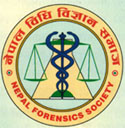NEPAL FORENSIC SOCIETY
Registered under the Nepal Law, Reg.No.622/053-54
|
|
JUSTICE BY FORENSIC SCIENCE
|
Source: Forensic chemistry network home page Forensic chemistry"Forensics" is a very broad term that just means analytical (generally used in reference to crime scene analysis). Thus, when looking for information on a Forensic Science you shouldn't just type in "Forensics," because you'll get everything from psychology to odontology. This site is dedicated to Forensic Chemistry, or analytical chemistry, applied to crime scene analysis. This would generally include bomb fragment analysis and various other types of chemical residue analysis. Forensic chemistryCourtesy: Wikipedia, the free encyclopediaForensic chemistry is the application of chemistry to law enforcement. Some forensic chemists may deal with explosives or poisons. The bulk of most forensic chemists work is on the analysis of controlled substances. According to federal and state laws an accurate net weight and positive identification of a substance must be obtained before a person can be tried for its possession, distribution or manufacturing. State and local regulations can vary, but in general an analysis must be accomplished based on certain weight criteria. After the weight is obtained the chemist may perform presumptive testing using chemical reagents that cause a color or odor change. The result of the presumptive tests give the chemist clues that guide what type of further testing is required. For the definitive identification of a substance there are several analytical instruments a chemist can use. One instrument is the gas chromatograph-mass spectrometer (GCMS), which is actually two instruments that are attached. The gas chromatograph is essentially a very hot oven holding a hollow coiled column. A drug sample is diluted in a solvent (e.g.: chloroform, methanol) and is injected into this column, the solvent will evaporate very quickly leaving the drug to travel through the column. The amount of time it takes the drug to travel through the column to a detector is recorded and compared to a known drug. (e.g. cocaine, methamphetamine, heroin, etc.) Gas chromatography alone is only a tentative identification. Once the drug has passed the detector it is sent into the mass spectrometer. A mass spectrometer identifies prominent ions of a drug. It accomplishes this by bombarding the drug with electrons, thus breaking it into its specific ions. This process is also recorded and the results are compared to the known drug. Another instrument used to identify controlled substances is Fourier Transform infrared spectrophotometer (FTIR). The FTIR records the bending and stretching of molecular bonds that are exposed to infrared light. The molecular bonds of all compounds react differently and create unique patterns upon exposure to a beam of infrared light. The unique pattern created is known as the fingerprint for that drug. As with the GCMS the results of the FTIR are compared to a known drug sample, thus producing a definitive identify. Source: Internet
|

